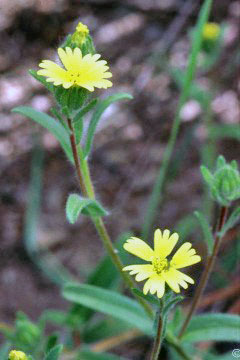 |
Slender tarweed, Madia gracilis
(Sm.) D. D. Keck (left).
The tarweeds are named for their strong aromatic odor. They grow to
mid-elevations in our mountains, although they’re not particularly common.
The plant is easily identified by its twice notched rays. It is widely
distributed in the west and is also native to Chile—the plant's generic
name comes from madi, the Chilean word for the plant.
The related Mountain tarweed Madia
glomerata Hook. is an odd little
plant. It stands straight, a foot of so high. The one shown here was growing
along the edge of a wet sub-alpine meadow. A few flower heads grow in small
clusters (botanically these are "glomerate," whence the species name). Each
flower head has only a few tiny rayflowers and several disk flowers. The
plants are covered with minuscule drops of sticky, strong-smelling fluid
. Touch the flowers and smell your fingers and you'll know why this is a
"tarweed." Although the slender tarweed has the same tar-like odor, it is
not nearly as strong as that of this plant. |
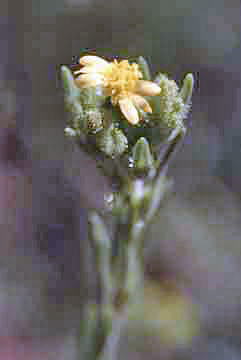 |
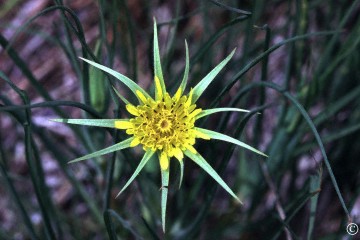 |
The Salsify, Tragopogon
dubius Scop. (left). As suggested
by the species name, dubius, the yellow salsify is part of a confusingly
interbred family that also includes the similar, blue-flowered European salsify
(the edible “oyster plant”). Tragopogon means
“goat’s beard,“ from its dandelion-like, feathery seed head
(right). Our salsify, shown on the right, is also an old world plant, imported
originally for its edible root. It is now a common roadside weed that seems
to be spreading further and further afield. The flower heads, which close
in the afternoon, are so characteristic that the plant is easily identified.
|
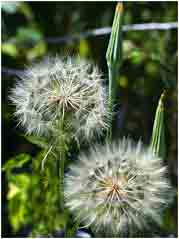 |
 |
Gaillardia, Indian Blanket, Gaillardia
aristata Pursh
(left). Our native gallardia is easily identified
by its reddish-brown-based petals and bristly, reddish-brown disk
(aristata means "bristly"). Meriwether Lewis collected a specimen
in today's Montana, near where his party crossed the Continental Divide on
July 7, 1806. The name Gaillardia honors an 18th C. French magistrate,
Gaillard de Marentonneau. Our flower is often confused with a related species,
the Firewheel, Gaillardia pulchella Foug,
(right), a showy plant that grows in our southern states. The firewheel
often escapes from ornamental gardens and lives wild, even though it is not
a native-to-Idaho plant. |
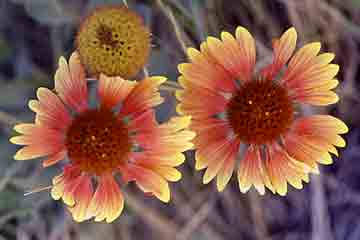 |
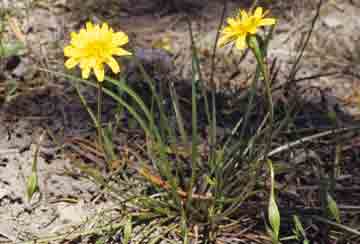 |
Mountain (or false) dandelion, Agoseris
glauca (Pursh) Raf. (left). Even
though it lacks a central disk and is somewhat similar in appearance to a
common dandelion (Taraxacum officinale), the mountain dandelion is
not related to the weed. It is characterized by a long bare stem, a terminal
flowerhead, and a few linear leaves that spring from a basal rosette. The
plant grows at all elevations, as high as treeline. The terms “mountain
dandelion,” or simply “agoseris” are used for the plant.
Orange mountain dandelion, Agoseris
aurantiaca (Hook.) Greene
(right). The orange agoseris is a relatively uncommon
plant that you’ll see from time to time during the summer months, usually
at higher elevations. It is an eye-catcher because of its burnt orange hue,
unusual among Asteraceae in our area.The species name aurantiaca,
from the Latin, means “orange-red” (the word is cognate with
“orange”). Its leaves are a bit wider than the agoseris shown above,
but otherwise the two are similar. |
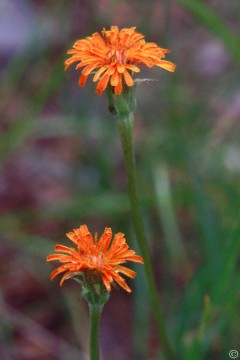 |
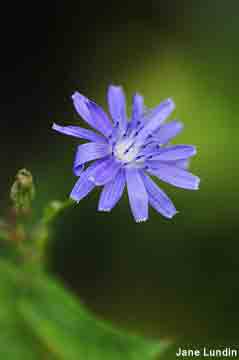 |
Blue lettuce, Mulgedium
oblongifolium (Nutt.) Reveal
(left). Although not a yellow flowered composite, we'll sneak
the blue lettuce in here as a relative of the prickly lettuce (right). The
blue lettuce (formerly and variously Lactuca pulchella and Lactuca
tatarica) is the showiest of our several native wild lettuces. Despite
its attractive flower-head, it is considered a weed. Its leaves, growth habit
and distribution are similar to those of the prickly lettuce, shown on the
right.
Prickly lettuce, Lactuca
serriola L. The prickly lettuce is
a common weed that blooms, usually on disturbed ground, from mid- to late
summer. An import from Europe, it grows throughout the United States.
The plant's insipid-yellow flower-head lacks disk flowers. Prickly, lobulated
leaves, prominently pointed buds and milky sap confirm the
identification. Several other wild lettuces, both native and
introduced grow in the Northwest: all are considered weeds. The word
“lettuce” was derived from the Latin word
“lactuca.” This in turn is related to the Latin word
lacteus, meaning “milky,” referring to the plants’
white sap. Lactuca serriola is believed to have an ancestral relationship
to edible lettuce, Lactuca sativa.
|
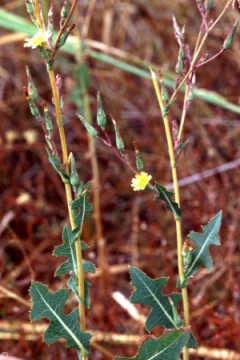 |









